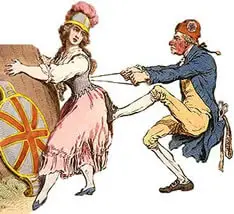Excessively rigid in matters of conduct; narrow or over-precise in one’s behaviour or moral judgement.
Strait-laced
What's the meaning of the phrase 'Strait-laced'?
What's the origin of the phrase 'Strait-laced'?
‘Strait’, which is often confused with its homonym ‘straight’, is a word that is rarely used alone but has stayed with us in expressions like ‘strait and narrow‘, ‘dire straits’, ‘strait-jacket’ and ‘straitened circumstances’. The meaning of those phrases becomes clear when we know that ‘strait’ means, not ‘free from curvature’, but ‘tight’. That usage goes back to the 13th century and an early example of the ‘tight’ meaning is found in John Trevisa’s translation of Bartholomew de Glanville’s De Proprietatibus Rerum, 1398:
A rynge that is streyghte on a fyngre and may not be take of afore mete, maye easely be take of after mete.
[De Glanville was clearly a messy eater.]
The confusion between ‘straight’ and ‘strait’ is understandable as some of the phrases above, for example ‘strait and narrow’, seem to make sense with the ‘straight’ meaning. It may be a help with spelling to remember the ‘tight’ meaning and that, for example, ‘strait-jackets’ aren’t straight jackets, they are tight jackets. The ‘straight/strait’ spelling muddle has also affected the understanding of ‘strait-laced’. It might have been thought (and I have to admit that I used to think this) that the adjective referred to the straightness of the tautly stretched lacing of women’s dresses. The phrase does indeed derive from the lacing of dresses and corsets but as a result of the clothing being tight, not because the lacing was straight.
Geoffrey Chaucer made a reference to ‘streyte’ clothing in The Canterbury Tales – Prologue, circa 1405:
Hir hosen weeren of fyn Scarlet reed Ful streyte yteyd.
[She was wearing fine, close gartered scarlet hose.]
The expression ‘strait-laced’ is found first in print, also in a Middle English text – John Lydgate’s My Fayr Lady, circa 1430. In the poem, for comic effect, Lydgate describes his beloved variously as ‘lyke as an olivaunt [elephant] and with ‘greet square shulderys brood’ [great broad, square shoulders]. Whether his ‘fayr lady’ enjoyed the joke isn’t made clear:
Hire crowpe doth the semys shrede, Whan they so streyght lasyd been.
[Her buttocks rip the seams of her clothes, which previously had been strait-laced.]
In the 16th century, ‘strait-laced’ began to be use figuratively to refer to people who were rigid in their beliefs and thinking. Thomas Martin’s religious tract The Marriage of Priestes, 1554, displays that usage:
He had to doe with certaine holy and straite lased heretikes, whiche denied it to be lawful for a Christian man after his baptisme to retourne to his wife.
In the 18th and 19th centuries, fashion dictated that women of quality wore exceptionally tightly laced corsets to emphasize their hourglass figures. The impression that we now have of ladies of the prim and formal Victorian upper classes is that they were strait-laced in more ways than one.
The history of “Strait – laced” in printed materials
Trend of strait – laced in printed material over time
Browse more Phrases
About the Author

Phrases & Meanings
A-Z
A B C D E F G H I J K L M N O P Q R S T UV W XYZ
Categories
American Animals Australian Bible Body Colour Conflict Death Devil Dogs Emotions Euphemism Family Fashion Food French Horses ‘Jack’ Luck Money Military Music Names Nature Nautical Numbers Politics Religion Shakespeare Stupidity Entertainment Weather Women Work
How did we do?
Have you spotted something that needs updated on this page? We review all feedback we receive to ensure that we provide the most accurate and up to date information on phrases.
